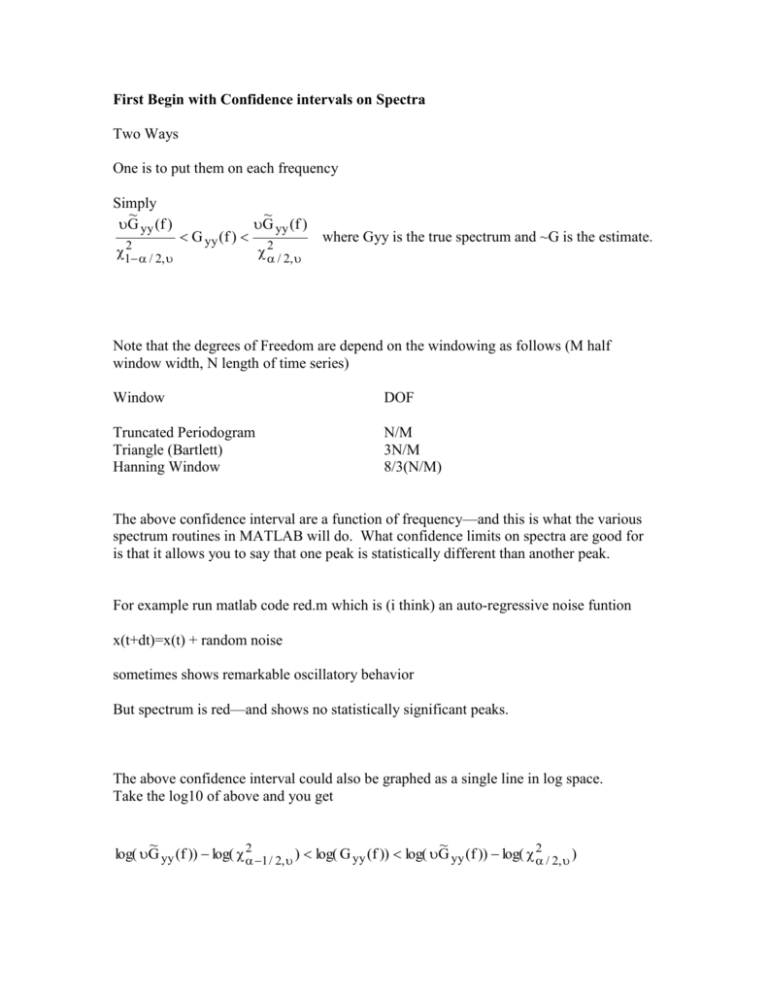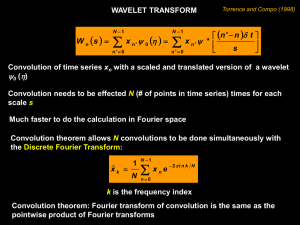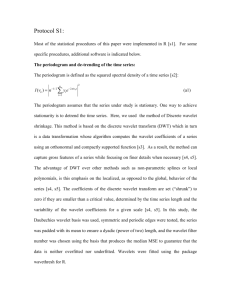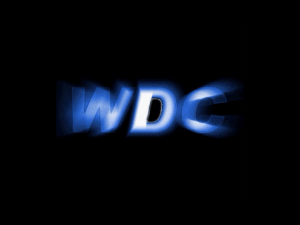Wavelet Analysis:
advertisement

First Begin with Confidence intervals on Spectra
Two Ways
One is to put them on each frequency
Simply
~
G yy (f )
12 / 2,
G yy (f )
~
G yy (f )
2
/ 2,
where Gyy is the true spectrum and ~G is the estimate.
Note that the degrees of Freedom are depend on the windowing as follows (M half
window width, N length of time series)
Window
DOF
Truncated Periodogram
Triangle (Bartlett)
Hanning Window
N/M
3N/M
8/3(N/M)
The above confidence interval are a function of frequency—and this is what the various
spectrum routines in MATLAB will do. What confidence limits on spectra are good for
is that it allows you to say that one peak is statistically different than another peak.
For example run matlab code red.m which is (i think) an auto-regressive noise funtion
x(t+dt)=x(t) + random noise
sometimes shows remarkable oscillatory behavior
But spectrum is red—and shows no statistically significant peaks.
The above confidence interval could also be graphed as a single line in log space.
Take the log10 of above and you get
~
~
2
2
log( G yy (f )) log(
1 / 2, ) log( G yy (f )) log( G yy (f )) log( / 2, )
Which can be written as:
~
2
2
log(
1 / 2, ) log( G yy (f )) log( G yy (f )) log( / 2, )
So simply the degrees of freedom and the confidence interval define the confidence limits
on a spectrum.
Wavelet Analysis:
“A practical guide to Wavelet Analysis” C. Torrence and .P Compo, Bulletin of the
American Meteorological Society. 1998.
http://paos.colorado.edu/research/wavelets/
Objective is to decomposing a time series into time-frequency space.
El Nino’s a good example of the need to do this because the statistics of the data changes.
Meaning that, for example, the frequency content of ENSO during the late 1800’s differs
in a statistically significant sense from ENSO during say the 1920’s.
Some of the earlier papers—such as Lau and Weng—do not present ways to access
statistical significance of wavelet analysis. This seems to me to be the biggest challenge
to convincingly using wavelets.
Windowed Fourier Transform represents on analysis tool for extracting local frequency
information from a signal. The Fourier transform is performed on a sliding segment of
length T and time step t. Segments can be windowed with arbitrary functions such a
box-car, cosine, Guassian etc.
But this is an inaccurate and inefficient method of time-frequency localization, because it
imposes a scale T into the analysis. This alias frequencies that do not fall into the
window.
Wavelet Transform.
Time series xn , n=0,1,2,…,N-1
And a wavelet function (for example the Morlet wavelet, consisting of a plane wave
modulated by a Gaussian) o ( ) 1 / 4e i o e n
2
/2
Where is a normalized time
The continuous wavelet transformation of a discrete series xn is defined as the
convolution of xn with a scaled and translated version of 0 ( )
1 N 1
( ' )t
x n *
N n ' 0
s
where s is the wavelet scale. By varying the s and translating along the localized time
index n one constructs a picture showing both the amplitude of any feature verses the
scale and how this amplitude varies with time.
Wn ( s)
While this above equation can be used to calculate the wavelet transformation it is much
faster to do it in the frequency domain (Fourier Space).
To approximate the continuous wavelet transformation the above convolution would be
done N times for each scale, where N is the number of data points in the record.
??By choosing N points the convolution theorem allows us to do all N convolutions
simultaneously in Fourier space using a discrete transformation
xˆ k
N 1
x
n0
n
e 2ikn / N
Thus by the convolution theorem the wavelet transformation is the inverse Fourier
transform of the product (note that the Fourier transform of a function ( t / s ) ( sw )
Wn ( s)
N 1
xˆ ( s
k 0
k
k
N
2k
N t : k 2
k
2k
N
:k
2
N t
)e iwk nt
What’s the deal with these frequencies greater than Nyquist? They are negative but
remain above 1/2dt
To ensure that the wavelet transform transformation at each scale are comparable the
wavelet function needs to be normalized for each s so that it has unit energy.
2s ˆ
o ( s k )
t
The wavelet functions in table 1 already are already normalized because
ˆ ( sw k )
| ˆ
0
( w ' ) | 2 w ' 1
Using these normalizations, at each scale s one has
N 1
k 0
| ˆ ( s k ) |2 N
Thus the wavelet transform is weighted only by the amplitude of the function xk and not
by the wavelet function.
Wavelet Power
Like the Fourier transform the wavelet transform is in general complex and is often
characterized in terms of it’s power and phase—identically as we’ve seen in the crossspectral analysis. However, for real value wavelet windows (such as Derivatives of a
Gaussian) DOG the imaginary part is zero.
The expectation value of the wavelet power is equal to N time the expectation value of
fft(x). For a white noise spectrum the expectation value is where is the standard
deviation.
Show Figure 1b
One can see the variations in the frequency of occurrence and amplitude of El Nino and
La Nina events.
Wavelet Power
One criticism of wavelet analysis is the arbitrary choice of the wavelet function ( though
waveletologists – which is what you all will be by the end of the lecture—will aruge that
the same arbitrary choice is made using the Fourier, Bessel, Legeendre transformation)
Still, there should be several factors which should be considered in choosing a wavelet
function.
Orthogonal or non-orthogonal
Orthogonal wavelet analysis gives the most compact representation of the signal but
suffers if there is an aperiodic shift in the time series the wave-let representation changes.
Conversely an non-orthogonal wavelet analysis is highly redundant at large scales where
the wavelet spectrum at adjacent times in highly correlated. This is useful for records that
show smooth variations in spectral characteristics. This is what is used in this paper.
Real or Complex
Complex returns phase information, a real only power, but is useful in pinpointing peak
frequency.
Wide/Narrow
It’s a trade off. A wide wavelet function will give good frequency resolution at the loss
of time resolution, while a narrow wavelet function will yield good time resolution and
poor frequency resolutions.
Shape
Reflect the type of feature in the time series. Records with sharp jumps of sets should use
a box-car like function such as the Harr, while for smoothly varying time-series a smooth
function such as a damped cosine is recommended. Power spectral estimates are not
sensitive to the shape of the function—but phase estimates are.
Plot Figure 2 (or MATLAT representation of wavelets)
Show figure 1c—using the real valued Mexican Hat wavelet (DOG), most notable
difference is the find scale structure picked up by the Mexican Hat function.
The Mexican hat is a narrow window – compared to the Morlet—and thus we see a finer
(broader) temporal (frequency) resolution of its wavelet then the Morlet.
Choice of Scales
For Orthogonal wavelet one is limited to a discrete set of scales (Farge, 1992)
For non-orthogonal you can use an arbitrary set of scales to build up a more complete
picture.
It is convenient to write the scales as fractional powers of two.
s j s o 2 jj j 0,1,..., j
J j 1 log 2 ( Nt / s 0 )
Where So is the smallest resolvable scale and J determines the largest scale. So should
be chosen to be equal to the Nyquist frequency.
For figure 1b N=506,t=0.25 years, so=2t, j=.125 and J=26 giving a total of 57 scales
ranging from 0.5 yr up to 64 years.
Cone of Influence.
The cone of influence is the region of the wavelet spectrum in which edge effects become
important.
Similar to spectral analysis errors will occur at the beginning and ends of the spectrum
because of the limited time series. In this example they padded with enough zeros to the
next power of two—this limits edge effects and speeds up fft.
Padding with zeros introduces discontinuities at the endpoints and, as one goes to larger
scales, decreases the amplitude near the edge as more zeros are added. The cone of
influence is the region of the wavelet spectrum in which effects become important. This
is defined as the e-folding time for the autocorrelation of wavelet power at each scale. It
is chosen so that the wavelet and ensures that the power for a discontinuity drops by a
factor of e-2 and ensures that edge effects are negligible beyond this point.
For a cyclic record—such latitudinal strip of the earth—no padding is needed and there is
no cone of influence.
Wavelet Scale and Fourier Frequency
The peak of the wavelet spectrum does not occur at the same peak frequency of the
Fourier transform (in figure 2 it should be 1).
Analytical relationships exist between the equivalent Fourier Period and the wavelet
scale. It can be derived by substituting a cosine wave of a known frequency into
Wn ( s)
N 1
xˆ ( s
k 0
k
k
)e iwk nt
and computing the scale s at which the wavelet power spectrum reaches it’s maximum.
For the Morlet wavelet with o=6 the Fourier wavelength s indicating that for this
Morlet wavelet scale is almost equal to the Fourier period.
Reconstruction
Wavelet transform is a bandpass filter with a know response function (the wavelet
function). This is done to check accuracy. For orthogonal wavelet transformation it is
straightforward by a deconvolution (deconv.m). For continuous wavelet transform one
reconstructs the time series by use of the delta function.
jt 1 / 2 J Re al {W n ( s j )}
xn
s 1/ 2
C ( 0) j 0
j
where sqrt(Sj) converts the wavelet transform to an energy density and the factor Cdelta
comes from the reconstruction of a delta function from its wavelet transform using the
function o ( ) . Cd is a constant for each wavelet function—and given in tables (Table
2 in the paper). If the original time series were complex then the sum would involve the
complex sum.
It is possible to calculate Cd for a new wavelet function—outlined in paper.
The total energy is conserved under the wavelet transform and the equivalent Parseval’s
theorem for wavelet analysis is:
2
jt
C N
N 1 J
n0 j 0
| Wn ( s j ) |2
sj
Again the reconstructed time series and the variance should be checked for accuracy and
to ensure that sufficiently small values of So and j have been chosen.
For the El Nino 3 case reconstruction of the time series has a mean square error of 1.4%
Theoretical Spectrum and significance levels.
To determine significance levels for either Fourier or wavlet spectra one first needs to
choose an appropriate background spectrum. It is then assumed that different realizations
of the geophysical process will be randomly distributed about this mean or expected
background—and the actual spectrum can be compared to the random distribution.
For many geophysical processes we can assume either a white-noise spectrum (flat) or a
red-noise spectrum (increasing power with decreasing frequency).
A. Fourier noise red spectrum
A simple model for red-noise is the univariate lag-1 autoregressive process (also called
the AR(1) or Markov)
x n x n1 z n
where alpha is the assumed lag-1 autocorrelation and zn is a random variable.
The discrete fourier transform of this (after normalization) is
Pk
1
1 2 cos(2k / N )
2
where k is the frequency index.
Thus by simply picking the right alpha we can model an red-noise process. For alpha = 0
this is a white noise process.
Figure 3.
FFT if EL-NINO is shown in figure 3 (thin line) (spectrum normalized by N/2
Thus a white noise spectrum would have values of 1 everywhere. The lower line is the
mean red-noise spectrum for alpha=0.72. Upper line is 95% confidence limits
If the time series can be modeled as a lat-AR process then the local wavelet power
spectra defined as a vertical slice through 1b is given by Pk above.
The average of all the local wavelet spectra approached the Smoothed fourier spectrum fo
the time seires.
Significanced Levels
The null hypothesis is defined for the wavelet power spectrum as follows: It is assumed
that the time series has a mean power spectrum (such as Pk=..). If a peak in the wavelet
spectrum is significantly above this background spectrum than it can be assumed to be a
true feature.
Since the square of a normally distributed variable is the chi-square distribution with one
degree of freedom, then | xˆ k | 2 is chi-squared with two degrees of freedom.
To determine the 95% confidence limits one multiplies the background spectrum Pk. By
the 95% value for chi-squared. Figure 3 Only a few points above this line.
In summary asumming a mean background spectrum – such as red-noise—the
distribution for the Fourier power spectrum is.
N | xˆ k | 2
1
2
Pk 2
2
2
2
(arrow indicates is distributed as).
The corresponding distribution for the local wavelet power spectrum is
| Wn ( s) |2
2
1
2
Pk 2
2
(18)
at each time n and scale s. (the ½ removes the DOF factor)
The vaule of Pk is the mean spectrum at the Fourier frequency k that corresponds the the
wavelet scale s.
Thus after finding an appropriate background spectrum and choosing particular
confidence interval for chi-squreed on can use 18 to construct 95 % confidence intervals.
As with Fourier analysis smoothing the wavelet power spectrum can be used to increase
the DOF and enhance confidence. Unlike Fourier analysis smoothing can be done in the
time or frequency domain.
The 95% confidence level for the Nino3 SST is shown by the thick contours on figure 1b
During the 1875-1910 and 1960-1990 the variance in the 2-8 year band is significant
above the 95% confidence limits. But from 1920-1960 there is little above this
signifanance level.
Confidence interval
Confidence interval is defined as the probability that the true wavelet power at a certain
time and scale lies within a certain interval about the estimated wavelet power.
Rewriting 18 as
| W n ( s ) |2
1 2
2
2
2
Pk
one can then replace the theoretical wavelet power Pk as with the true wavelet power
defined as W (s). The confidence interval for the true wavelet power is then
2
2
| W n ( s ) | 2 | W n ( s ) | 2 2
| W n ( s) |2
( p / 2)
2 (1 p / 2)
2
2
Steps for Wavelet analysis:
1) Choose mother wavelet
2) Find (analytical) Fourier transform of mother wavelet
3) Obtain FFT of time series
4) Define scales s
s(1)= Nyquist Frequnency
keep doubling frequencies until period ~ ½ of record
5) For each scale W(s)
Normalize wavelet by standard deviation (this is called the daughter wavelet)
Multiply FFT of data by FT of nomalized wavelet
Take inverse FFT of above
6) COntour result
7) Define confidence limits based on auto-regressive red spectrum







